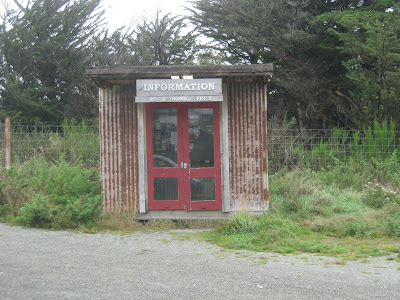An old bridge, no longer used..
On one side of the bridge, an abandoned information booth. Not very helpful, but amusing.
We stopped at McCracken's Rest, at Te Waewae Bay. Couldn't resist a few jokes about the name.
We don't know who McCracken was, but the views were lovely at his resting point.
Back on the road, we were held up by a herd of sheep crossing the road.
Next stop: Waipapa Point, site of a beautiful lighthouse built in the 1880s in response to a tragic shipwreck in 1881 that killed almost all passengers on board. (The coastline of the Catlins, notoriously dangerous, has been the site of many shipwrecks over the years.)
At Waipapa Point, we spotted some sea lions, common in the Catlins region:
The weather was lovely and we enjoyed the sun, scenery, and very few tourists (quite a change from the rest of the country!).
 |
| Yes, I took a photo of the grass. But it was such a cool texture! |
Our next stop along the southern scenic route was Slope Point, the southernmost tip of New Zealand's south island. There's no road out to the point; it must be reached by a 20 minute walk through sheep farmland.
The wind is so strong in this coastal areas that we saw lots of trees growing sideways. Someone had build a sort of shelter here nestled in the trees.
Along the drive, some breathtaking views:
Next stop: Curio Bay, best known as the site of a petrified forest (dated back 180 million years, no big deal) and home to the rare yellow-eyed penguin.
Weird seaweed at Curio Bay... lots of tubular objects with tons of balls that had fallen off.
The petrified trees have been whittled down over the years, but here you can see part of a trunk. They were buried by ancient volcanic mud flows and gradually replaced by silica to produce these fossils exposed by the sea.
We spotted a yellow-eyed penguin, one of the rarest type in the world, in the afternoon. It's hard to see this photo because of the sun's glare.
That evening we enjoyed a lovely sunset near Curio Bay.

































Mary Long. You are having incredible adventures. Keep enjoying, exploring and growing! xoxoxoxo
ReplyDelete